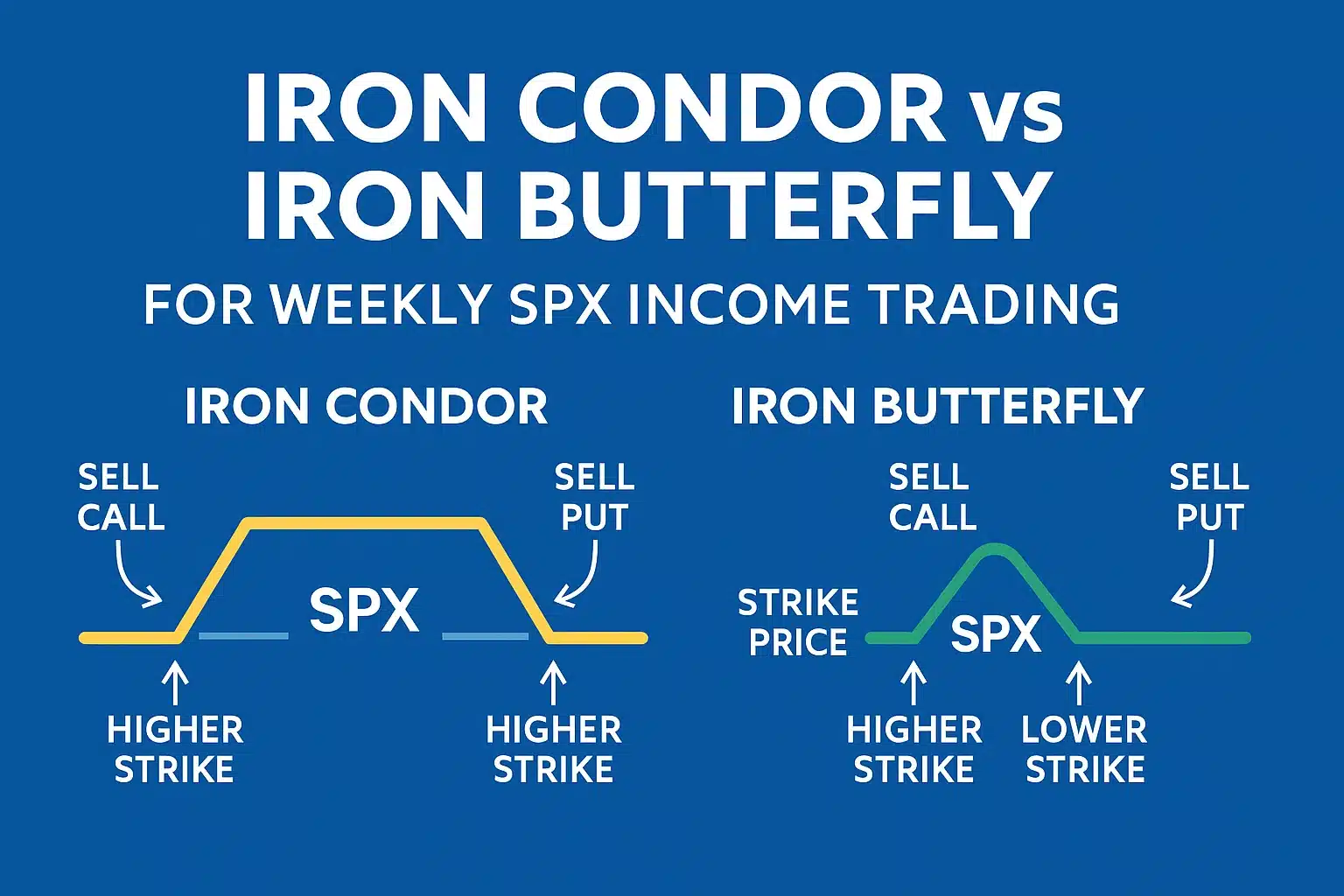Over the past 20 years, I’ve traded both on SPX—manually and through full automation. In this article, I’ll walk you through the key distinctions, real-world examples, and why I’ve chosen one over the other in my own trading business.
If you’re new to Iron Condors, start with our main guide —
Iron Condor SPX Strategy: Profit From Low Volatility Safely.
It explains how SPX Iron Condors work, when to trade them, and how professionals manage risk.
What Is an Iron Condor?
An iron condor is a neutral, defined-risk spread built by combining a short put spread and a short call spread with the same expiration date. The goal is simple: profit when the underlying stays within a specific range.
Want a deeper dive into how this strategy works? Check out our detailed guide on the Iron Condor Strategyto understand how we optimize trade setups week after week.
Structure
- Sell 1 out-of-the-money (OTM) put
- Buy 1 lower-strike OTM put
- Sell 1 OTM call
- Buy 1 higher-strike OTM call
Key Benefits
- Defined risk and reward
- Wider profit zone than iron butterflies
- Ideal for sideways markets
- Perfect for automation due to rules-based setup
Example
With SPX at 5,300:
- Sell 5,220 Put / Buy 5,210 Put
- Sell 5,380 Call / Buy 5,390 Call
- Net Credit: $2.00
- Max Risk: $8.00
- Breakevens: 5,218 and 5,382
- POP: Over 90%
This is the exact type of trade we run inside Weekly Premium — targeting 5–10% ROI in just two trading days.
What Is an Iron Butterfly?
The iron butterfly is built using the same legs as the condor – but here, the short call and short put are placed at the same strike price, typically at-the-money. That gives you a narrower profit range, but a larger potential payout if the underlying finishes exactly at that strike.
Structure
- Sell 1 ATM put
- Buy 1 lower-strike put
- Sell 1 ATM call
- Buy 1 higher-strike call
Key Characteristics
- Higher reward if pinned at short strike
- Narrow profit zone
- Lower probability of profit
- Requires precise movement
Example
SPX at 5,300:
- Sell 5,300 Put / Buy 5,290 Put
- Sell 5,300 Call / Buy 5,310 Call
- Net Credit: ~$10.00
- Breakevens: 5,290 and 5,310
- POP: Around 35–40%
While you collect more premium, this setup leaves little room for error — not ideal for automated or passive trading approaches.
Iron Condor vs Iron Butterfly: Key Differences
| Feature | Iron Condor | Iron Butterfly |
|---|---|---|
| Short Strike Placement | Different (OTM call & put) | Same (ATM call & put) |
| Profit Zone Width | Wide | Narrow |
| Max Credit | Lower | Higher |
| POP | Over 90% | ~35–40% |
| Best Used For | Weekly SPX Income | Event-driven trades |
| Automation-Friendly | Yes | No |
Which Strategy Is Better for Weekly Options?
If you’re trading weekly options – especially on SPX – you want consistency, defined risk, and minimal management. For that, iron condors come out on top every time.
- Wider breakeven range
- Better probabilities
- Ideal for automation
- Stress-free position sizing
Want to automate your weekly SPX iron condor trades?
Our Weekly Premium Signal Service delivers 1 high-probability trade per week – with 5–10% ROI targets and fully automated execution.
Start with as little as $1,000 account balance.
What Is the Success Rate of the Iron Butterfly Strategy?
The iron butterfly typically has a 35–45% probability of profit, depending on how close the short strike is to the current price and how wide the wings are placed.
Because the short call and short put sit at the money, the position only wins if price finishes in a very tight range at expiration. That narrow profit zone means the reward is high, but the success rate is much lower than an iron condor.
This is why iron butterflies are better suited for event-driven trades where you expect little to no movement—not for weekly income trading or automation.
Reverse Iron Condor vs Reverse Iron Butterfly
| Feature | Reverse Iron Condor | Reverse Iron Butterfly |
|---|---|---|
| Bias | Volatility expansion, large moves | Very large moves or spikes |
| Short/Long structure | Long OTM call + long OTM put | Long ATM straddle + short wings |
| Width of profit zone | Wide | Narrow |
| Max reward | Moderate | High |
| Probability of profit | Higher | Lower |
| Best use case | Pre-event volatility | High-impact catalysts (earnings, FOMC) |
Real-World Example: Weekly SPX Iron Condor vs Iron Butterfly
Setup: SPX at 5,300 | 2 Days to Expiry
Iron Condor
- Sell 5,220 Put / Buy 5,210 Put
- Sell 5,380 Call / Buy 5,390 Call
- Net Credit: $2.00
- Max Risk: $8.00
- POP: Over 90%
- Breakeven Range: 5,218 to 5,382
Iron Butterfly
- Sell 5,300 Put / Buy 5,290 Put
- Sell 5,300 Call / Buy 5,310 Call
- Net Credit: ~$10.00
- Breakeven Range: 5,290 to 5,310
- POP: ~35–40%
While butterflies offer more potential payout, the narrow range makes them hard to automate and even harder to win consistently. Condors, on the other hand, offer peace of mind and repeatable edge.
Is an Iron Condor Always Profitable?
No — an iron condor is not always profitable, but it does offer one of the highest probabilities of profit among defined-risk strategies.
A far-OTM iron condor on SPX typically has:
80–95% probability of profit
Defined max loss
Wide breakeven range
But an iron condor can still lose money when:
A large directional move breaches one of the spreads
Implied volatility spikes unexpectedly
Traders skip stop-loss or adjustment rules
When used with disciplined sizing and systematic exits (as in your Weekly Premium model), the iron condor becomes a consistent income strategy—not a guaranteed win every week.
Should You Trade Both?
You can – but not for the same reasons.
Iron condors are your steady income play. They’re ideal for SPX, automation, and relaxed management. Iron butterflies are more surgical – best used when you expect little to no movement and can monitor the position closely.
If you’re looking for consistent, rules-based income, you can’t beat the simplicity and success rate of the far-OTM iron condor approach.
There are also alternative approaches to iron condors worth exploring, like theReverse Iron Condor – a directional play often used during earnings or major market catalysts.
Ready to Trade Iron Condors Automatically?
Want consistent weekly income from SPX options — without screen time or stress?
With our Weekly Premium Signal Service, you get:
- 1 SPX iron condor trades per week
- 5–10% ROI in 2 trading days
- 100% automation with supported brokers
Frequently Asked Questions
What is the main difference between an iron condor and an iron butterfly?
Iron condors use two different short strikes, creating a wider profit range. Iron butterflies use the same short strike, offering a higher reward but a narrower breakeven range.
Which strategy is safer for beginners?
Iron condors are generally safer because of their wider range and higher probability of success.
Can I automate iron condor trades?
Yes – our Weekly Premium service does exactly that. You can set it and forget it.
We also offer trade setups for variations like the Short Iron Condor– perfect for traders looking for fast, rules-based entries.
Why use $10-wide condors placed 80 points away?
This setup gives you a high POP (90%+), defined risk, and a reliable return between 5–10% with limited exposure.
Can this work with a small account?
Absolutely. You can start with as little as $1,000 account balance, thanks to the defined-risk nature of the spreads.
What Is the Difference Between an Iron Fly and an Iron Butterfly?
There is no difference between an iron fly and an iron butterfly — they are the same strategy.
“Iron fly” is just shorthand used by traders to describe the iron butterfly setup:
Sell ATM call
Sell ATM put
Buy long wings for protection
The payoff shape resembles a “butterfly,” which is where the full name comes from.
What Is the Difference Between a Reverse Iron Condor and a Reverse Iron Butterfly?
Both reverse structures are debit spreads designed to profit from big moves, not stability — the opposite of traditional condors/butterflies.
But they differ in structure and price behavior:
Reverse Iron Condor
Built with OTM debit call spread + OTM debit put spread
Profits from large moves in either direction
Wider profitable zone than reverse iron butterfly
Lower potential reward, higher probability
Reverse Iron Butterfly
Built with long ATM straddle plus OTM wings
Profits from very large moves or volatility spikes
Narrower profitable zone, larger potential reward
More sensitive to volatility and timing
Quick summary:
Reverse iron condor → wider range, lower payoff
Reverse iron butterfly → narrower range, higher payoff


